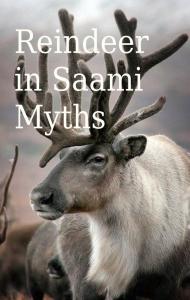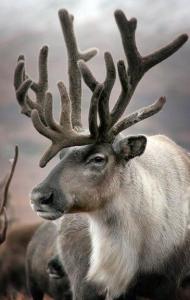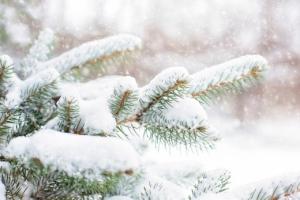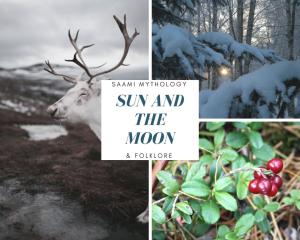
Living In Balance With Nature
Saami people are the native people of northern Europe. Saami land reaches from the northern parts of Norway, Finland and Sweden to Kola peninsula in Russia. In these modern times, you can find saami in all kinds of professions but back in the day’s majority of the saami were fishermen, hunters and above all reindeer herders. The nomadic lifestyle was a natural way of life for many saami. They knew all about the constellations, movements of the sun, moon, stars and the northern lights. Saami stories and folk tales were told orally from one generation to another. A few hundred years ago in Finland, Sweden and Norway pagan beliefs of the saami were suppressed and many saami converted to Christianity. Because of this, slowly old stories vanished. Now we have only fragments left of the Saami myths and legends.
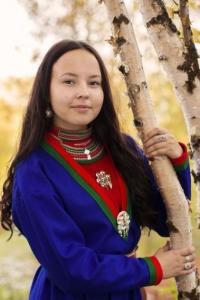
Beiwe The Sun Goddess
Because there are many different Saami languages the written form of the names varies. Sun was called Beiwe/Beaivi. In the Saami culture deities were not always personified. Often deities were seen as invisible spirits living inside rocks, rivers, stars, northern lights and such. Beiwe was one of the most important deities in the Saami culture because during winter in Lapland sun does not come out at all. The darkness lasts several months and even though snow reflects moonlight, darkness still had its effects on the mental health and well-being of the people. Sun was greatly missed during the long winter months. Summer was seen as a time of warmth and abundance.
When the sun was in its human form it was called Beaivvi Nieida the sun maiden. Beaivvi Nieida was connected to spring and fertility. Her sacred animal was the white reindeer. During summer solstice people made sun wheels from twigs, flowers and leaves and hung them into the trees. Sun goddess was connected to the fertility of the earth and well being of plants, flowers and animals.
There was a custom to sacrifice white animals to Beaivvi Nieda in the midwinter ritual to welcome back the sun. If there were no white animals available, animals who had white ribbons attached to their ears were sacrificed. Another tradition that was part of the ritual was too lit fires that represented the sun. There was a custom to sprinkle fat on the door edges which the sun would eat and become stronger before turning back to the sky after its long rest. Animal sacrifices were only made during winter. Otherwise, that would have been impolite because flames might have been shining brighter than the sun itself.
Gifts for the sun
In the Lapland of Sweden, there was a custom to bake so-called “sun cakes” from reindeer blood. These cakes were hung into the trees and were left for the sun to “eat”.
In the Lapland of Norway Saami left sacrificial porridge for the sun.
These sacrifices were made to make sure that reindeer would stay healthy so that predators would not get them and to cure sicknesses.
In February there was a custom for people to gather together into groups and walk to the ice to watch their first glimpses of the sun after long dark months. Sun was greeted by bowing (this is a custom that was also practised by several Finno-Ugric and Baltic tribes).
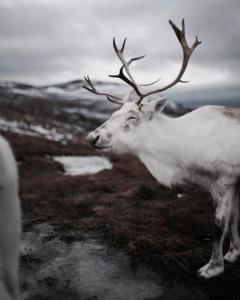
Three Goddesses Of Spring
In Saami mythology, there are three goddesses that are connected to the spring. Sometimes these goddesses are seen as aspects of Beaivvi Nieda and sometimes they are portrayed as three different individuals.
Sala Niejta (Uumaja Saami) was a female spirit who had the power to order snow and freezing air to leave so she could bring the spring with her.
Rana Niejta (also known as Rana Niete, Rana Neida and Radien-Neito) was the goddess of the earth. Her name literally means green fields/green grounds. She made the flowers and the herbs grow and turned mountains green in the summer. Rana Niejta belongs to the family of Radien-Spirits who was a group of Saami deities that had power over human lives.
Servge Edni was the third goddess in the group. She was one of the spring maidens bringing new life with her.

Mánnu The Moon
When the sun was many times described as feminine, the moon in the Saami myths was described to be masculine. Since there was very little daylight, winter was considered to be a suspicious time with lots of evil spirits wandering among the living, Mánnu being one of them. People thought Mánnu was a very suspicious spirit. Why he came out to the skies during the night when all nature was asleep?
Older stories describe the moon more as a magical and mysterious spirit. Later on, with more influences coming from Christianity moon got more bad reputation and features from the Christian devil.
December was believed to be the month when there were evil spirits wandering around and the moon was sometimes described to be their leader. People were very careful not to irritate the moon. During December people did not like to stay outside for long periods of time. It was not allowed to do loud chores like chopping firewood and women were careful not to gossip or laugh.
In February when the sun was coming back people gathered together outside under the full moon. They had pans and drums with them and they made loud noises to distract the moon and told him to go away so that the sun may return.
The battle between the sun and the moon is something that can be found in many myths and stories around the world. Suspicion towards the moon comes from people´s fear towards the night and darkness. During the time without no electric lights when people did not know that much about the surrounding world, it was easy to let one´s imagination run wild and imagine all kinds of dangers that were waiting in the dark. Returning of the sun was a promise of hope.
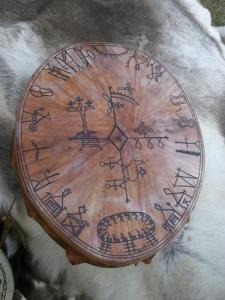
Sun In The Shaman Drums
In Saami shaman drums sun, the moon and the stars are common motifs. In so-called heliocentric drums, the sun is painted in the middle of the drum. Saami drums are quite exceptional when it comes to shaman drums. In different cultures, drums, where the skin is completely decorated with patterns, can only be found in the Saami and among some tribes in Siberia who speak Samoyed languages.






